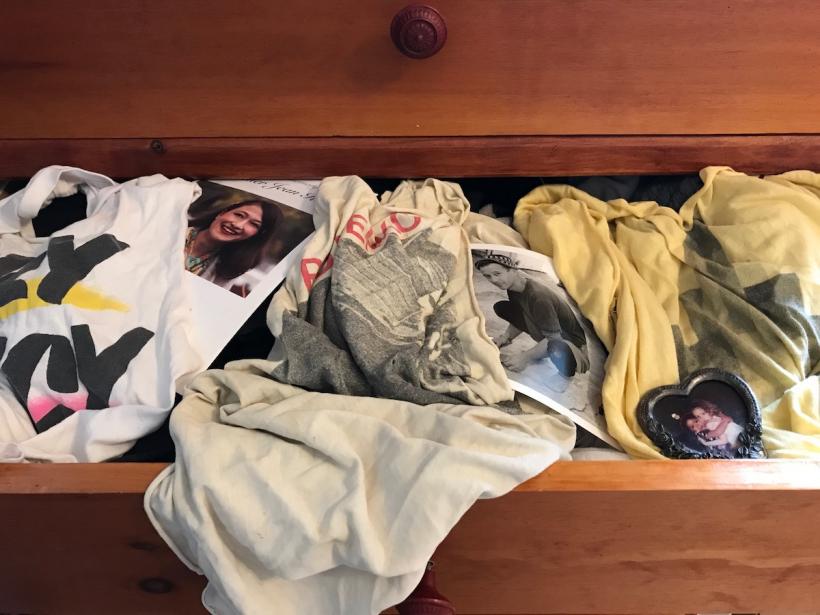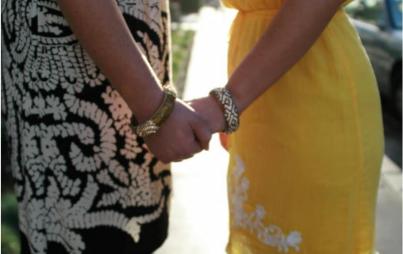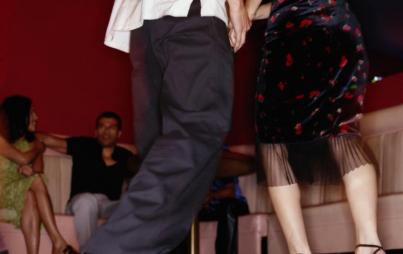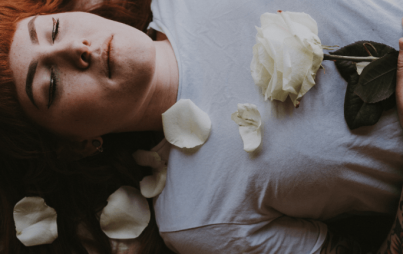
Photo: Lilly Dancyger
Long Reads is a bimonthly feature, showcasing long-form essays.
CN: death, suicide
It’s not unusual to keep talismans of people we’ve lost — often jewelry given as gifts by the deceased while they were still alive, or sometimes inherited. Photographs, letters. But wearing a dead person’s clothing (not clothing that they gave to you while they were living, but articles that they put on their bodies while those bodies still breathed) provides a feeling of corporeal closeness that’s hard to replicate. A closeness that anyone who’s grieved can understand the depth of craving for.
Three of my favorite t-shirts used to belong to dead people. I wear them when I want to feel my departed loved ones close to me. It might be mildly morbid. It feels significantly more macabre than wearing jewelry or clothing that these people gave to me when I was alive.
But that same thing that makes it just a little bit creepy is also what makes it so comforting — it’s the closeness to their physical bodies, to bodies that aren’t here anymore.
It’s the fact that their skin used to brush against the inside of these t-shirts, that they sweat in them. I’ve washed them all since then, yes, but something about that essence is still there.
The Rodchenko Shirt
This shirt features a photograph by one of my father’s favorite Russian Constructivist artists, Alexander Rodchenko. It came to me already worn thin, the sleeves cut off, the white cotton now far from white. The fact that it’s coming apart in a few places, the fabric worn threadbare, makes me hesitant to wear it too much because I know it will eventually disintegrate entirely. I savor it, wearing it only when I need to.
When I do wear it, accepting the cost of another day’s wear bringing it closer to destruction, someone inevitably comments on the striking image of the photograph or asks what the Cyrillic lettering says. And then I get to tell them about my father’s beloved Rodchenko, get to spread the gospel of the turn-of-the-century Russian art movement that was all about working in as many mediums as possible, of integrating one’s art with one’s life. I get to be connected to the art world conversations that my father was always having and should still be having, that I feel connected to but not fully qualified to participate in without a catalyst like this one.
And I get to explain that this was his shirt — that he was once a person with a body, not just a memory that I evoke maybe a little too often.
The majority of the people that I know now never met my father. They only know about him because I talk about him, because he’s part of the mythology of my life. But it’s easy to think of someone you never met as just an idea, as a collection of stories. But an idea doesn’t wear clothing. The fact of his shirt leads to the fact of his body, to his construction-toned arms that would catch me mid-air when I’d run and leap at him at bus stops after not seeing him for weeks or months, his stubble-covered face, deep smile lines just starting to form. The smell of cigarette smoke and plaster.
My father died when I was 12 years old. He was only 43. He had just finally kicked a long-standing heroin habit, but the damage had already been done. He lived in California, and I lived in upstate New York, and we were both looking forward to a visit that we had planned — we were going to sleep under the redwoods. I talked to him on the phone the day he died; he said he wasn’t feeling well and that he was going to take a nap. He never woke up.
My father was an artist — a sculptor and painter — whose work fills my apartment. I’m lucky in that way — that this monumental loss left behind so much tangible beauty to cling to. That art stays cloistered in my home. It welcomes me after a long day spent out in the world where my father isn’t. But when I wear his t-shirt, I’m carrying a bit of him out into that world, where everyone can see it.
The Middle Finger Shirt
My cousin Sabina was one year and ten days younger than me. Cousin is too open-ended a word; people have cousins they’ve met once, cousins they can’t keep track of. Technically we were cousins, but really we were sisters. She was the first person I consciously, truly loved, besides my parents. I was the interpreter of her baby-talk and her biggest fan.
Once, when I was three, and she was two, we woke up before the grown-ups, and she told me she was hungry. I could wait for my breakfast, but I couldn’t wait for hers, so I took her by the hand and led her to the kitchen. I pulled a chair over to the counter, where I climbed up and dug around in the cupboards until I found a salad bowl. When our mothers woke up, they found us sitting on the floor, covered in milk, sharing an entire box of soggy cereal.
We got older, but that was always how I felt about her — that if she were hungry, I would climb obstacles taller than myself and pour her a whole week’s worth of breakfast.
Sabina was about to turn 21, a stunning budding model and musician, adored by everyone who was lucky enough to get near her. I’d promised to come to Philadelphia from New York to go to her party, at a club where she’d already been a regular for two years. We’d giggled on the phone about what on earth I was going to wear to such an event, and made excited plans for me to borrow her clothes — just a more grown-up version of the same game of dress-up we played together so many years ago.
Three weeks before the party, she was raped and murdered, steps away from her front door, on her way home from a friend’s house.
I was in another state, but the part of me that had always been her big sister felt like I should have been there to fight him off, to protect her and usher her safely inside, to wipe the tears from her face, and hug her until it was all better.
I’d been an angry teenager, but that was nothing compared to the anger I felt as a 22-year-old, reeling from Sabina’s death.
After the funeral, her mother, my aunt, handed me a yellow t-shirt with a pixelated middle finger on it, that had been Sabina’s, and said, “I thought you should have this.”
I thought, yes, I should have it!
It was perfect — the sunny yellow that was more Sabina than me, and the middle finger that could say to the world what I was feeling at all times. Between the two of us, I’d been the loud, abrasive, angry one, wrapping my arm around her protectively, flipping off the world. And now I can do it for her with clothing.
With Sabina especially, the issue of her having had a body is an important one. Her body that was so horribly mistreated at the end, I have to remember that it wasn’t always like that. Her body loved to dance, and gave hugs that always enveloped my entire face in her thick black hair. After she died, I dreamed about her hair — about her head on my lap, my hand petting her head. Her body was always just a little bit shorter than mine, so we naturally fell into our standard position of her leaning a head on my shoulder, my arm around hers. Her body used to wear this goofy t-shirt.
The "Very Fancy" Shirt
Heather was one of my best friends when we were teenagers, and one of the few from that time that I maintained a connection with as we became adults. We’d go months without talking, but when we finally did manage to catch up, we always clicked right back into our giggly, fiercely loving friendship.
One of the last times we saw each other, we met at a Greek restaurant in Astoria, where we used to go as teenagers because they didn’t card and the wine came in cheap carafes that made us feel fancy and illicit at the same time. We caught each other up on the last several months of our lives: she was working as a legal secretary but wanted to go back to school, I was bartending and wishing I could write full time. We had a long conversation about retail therapy. We both grew up without money, and we talked about the poor-kid guilt we still felt about buying ourselves things we wanted but didn’t need. And about how that guilt was outweighed by how much a nice blouse really could make you feel better.
When she killed herself a few months later, the weekend after Thanksgiving, I was one of the three friends who went with her father and her sister Jenn to clean out her apartment. I felt so much guilt for the fact that I’d never been to this apartment while she was alive. We’d talked about me coming over for dinner a few times, but it just never happened. I always thought it would, and then it was too late. There was a postcard hanging above her bed that I’d sent her from Paris almost a decade earlier. Of course, this made me sob. I took it down and tucked it into my purse to take with me.
I also took one of her t-shirts.
As we stuffed her clothes into garbage bags to take to a Jewish charity that she’d volunteered with when she was alive, we kept an eye out for the dress Heather had worn to her sister’s wedding — Jenn wanted to keep it. I shoved fistfuls of her retail therapy purchases into bags and wished I could go back to that conversation and state the obvious: sometimes you need real therapy.
I came across a white t-shirt with the words “Very Fancy” on it; I laughed. There hadn’t been a lot of laughter that day, as we packed away the place she’d lived, and then died. But when I saw the shirt, I heard Heather’s voice in my head (our best approximation of the classic old-New-York-Jewish-lady voice we thought we'd both age into eventually) when she told me to zip up my jacket because it was cold or insisted that I couldn’t possibly have eaten enough. “Very fancy!” We were kids together, and we were each other’s mothers, each of us wanting for a real one, in different ways.
The shirt made me hear Heather’s voice, so of course, I had to have it. It became one of my favorite bartending shirts — in the venue where I was most visible. Whenever someone would compliment me on it, which happened at least once each time I wore it, I’d say, “Thanks! It’s my friend Heather’s,” and then in my mind, I’d give her a little pinch, a nod to how stylish and gorgeous she always was.
I know she’d get a kick out of the fact that her clothing choices are still getting positive responses from the public. And I only found out by wearing it that this is, in fact, a very hip, insidery shirt, made by Baron von Fancy, who I’d never heard of. This was all too fitting, seeing as how Heather was always cooler than me. And now I have a reminder of that, too.
♦♦♦
When people die, we talk about keeping their memory alive. We don’t forget them, and in that way, they’re always with us. In a profound way, this is true. My father, Sabina, and Heather are all burrowed deep into my soul, such important parts of who I am that they continue to exist every time I breathe.
But in an equally deep way, anyone who’s mourning knows that’s crap. It’s not their memories we want to hold onto, to wrap our arms around and dig our nails into and breathe in the smell of. The truth is that no matter how often we think of them or how much we honor their memories, they are not here. Without their bodies, they become ideas. They become intangible, and when enough time passes, they can, painfully, start to dissipate.
I know my tendency to wear dead people’s clothing is a little odd. A little dark. But it’s the closest I can get to holding onto the physical presence of these people who no longer have bodies.








